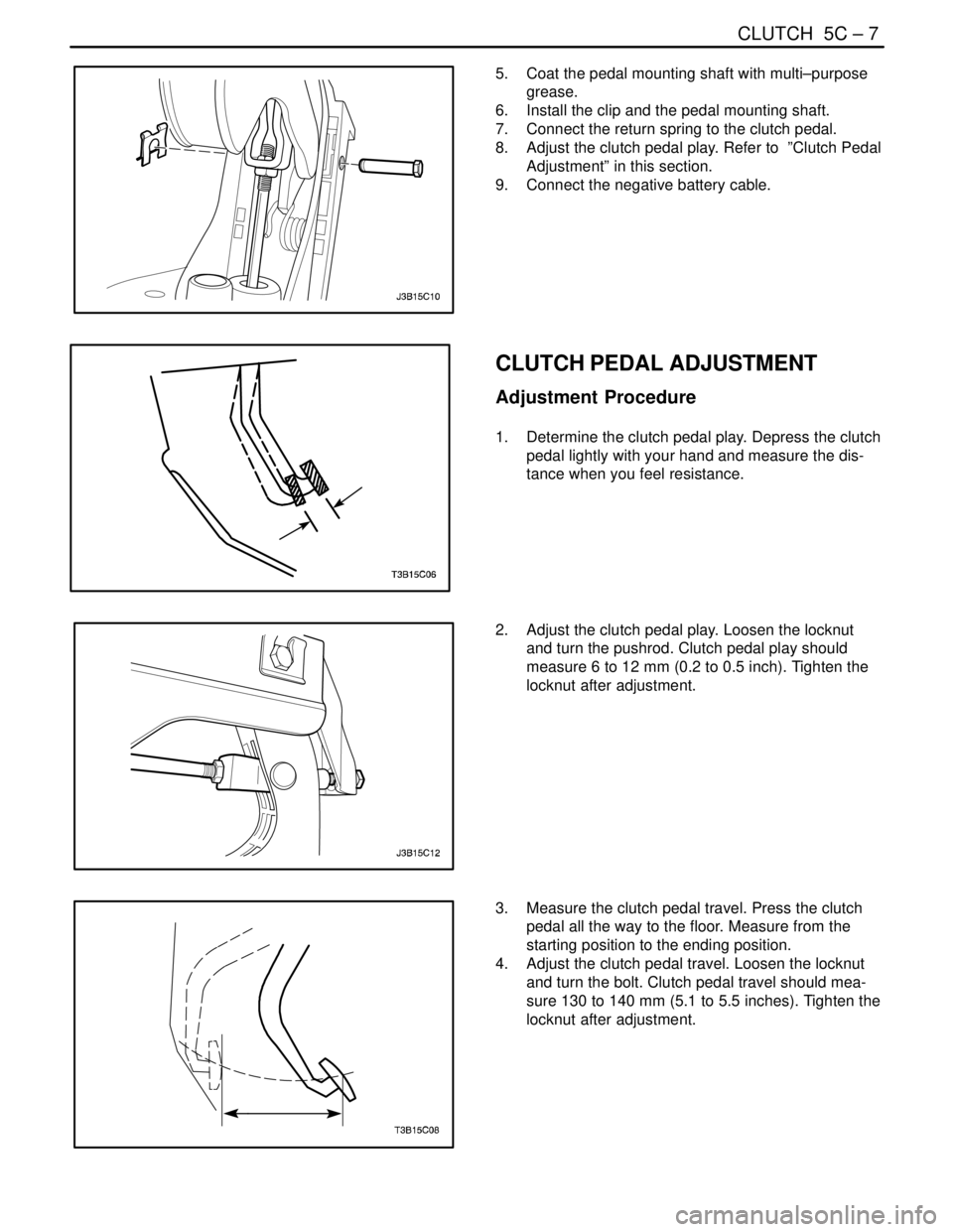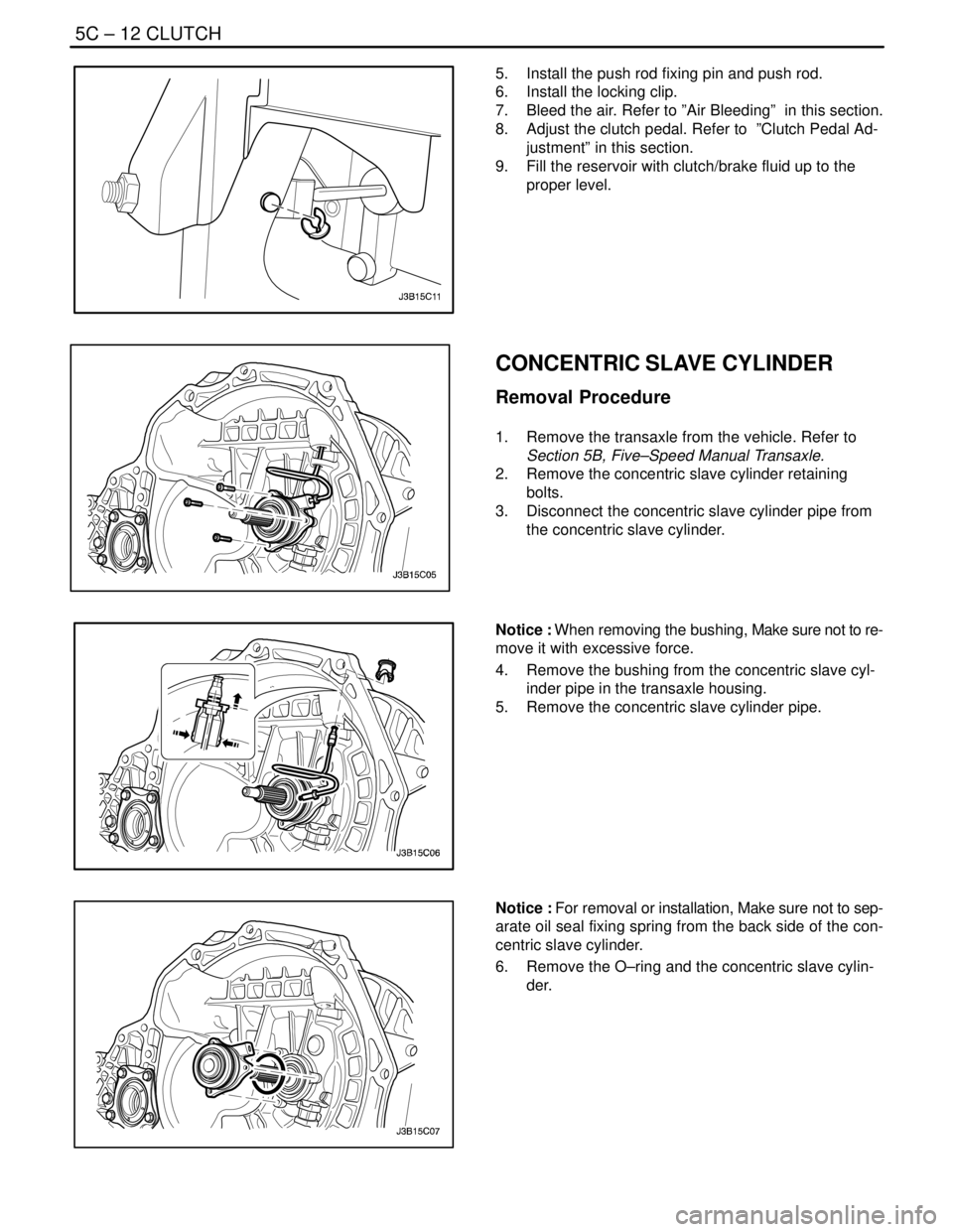Page 1888 of 2643

SECTION : 5C
CLUTCH
CAUTION : Disconnect the negative battery cable before removing or installing any electrical unit or when a tool
or equipment could easily come in contact with exposed electrical terminals. Disconnecting this cable will help
prevent personal injury and damage to the vehicle. The ignition must also be in LOCK unless otherwise noted.
TABLE OF CONTENTS
SPECIFICATIONS5C–1 . . . . . . . . . . . . . . . . . . . . . . . . . .
Fastener Tightening Specifications 5C–1. . . . . . . . . . .
SPECIAL TOOLS5C–2 . . . . . . . . . . . . . . . . . . . . . . . . . . .
Special Tools Table 5C–2. . . . . . . . . . . . . . . . . . . . . . . .
DIAGNOSIS5C–2 . . . . . . . . . . . . . . . . . . . . . . . . . . . . . . . .
Clutch Operation 5C–2. . . . . . . . . . . . . . . . . . . . . . . . . .
COMPONENT LOCATOR5C–4 . . . . . . . . . . . . . . . . . . . .
Clutch Components 5C–4. . . . . . . . . . . . . . . . . . . . . . . .
MAINTENANCE AND REPAIR5C–6 . . . . . . . . . . . . . . .
ON–VEHICLE SERVICE 5C–6. . . . . . . . . . . . . . . . . . . . .
Clutch Pedal 5C–6. . . . . . . . . . . . . . . . . . . . . . . . . . . . . . Clutch Pedal Adjustment 5C–7. . . . . . . . . . . . . . . . . . . .
Clutch Release Point Adjustment 5C–8. . . . . . . . . . . .
Air Bleeding 5C–8. . . . . . . . . . . . . . . . . . . . . . . . . . . . . . .
Pressure Plate and Clutch Disc 5C–8. . . . . . . . . . . . . .
Clutch Master Cylinder Assembly 5C–10. . . . . . . . . . .
Concentric Slave Cylinder 5C–12. . . . . . . . . . . . . . . . . .
GENERAL DESCRIPTION AND SYSTEM
OPERATION5C–14 . . . . . . . . . . . . . . . . . . . . . . . . . . . . .
Driving Members 5C–14. . . . . . . . . . . . . . . . . . . . . . . . .
Driven Members 5C–14. . . . . . . . . . . . . . . . . . . . . . . . . .
Operating Members 5C–14. . . . . . . . . . . . . . . . . . . . . . .
SPECIFICATIONS
FASTENER TIGHTENING SPECIFICATIONS
ApplicationNSmLb–FtLb–In
Clutch Master Cylinder nuts2216–
Concentric Slave Cylinder Retaining Bolts7–62
Concentric Slave Cylinder–to–Clutch Oil Pipe Screw1511–
Pressure Plate–to–Flywheel Bolts1511–
Page 1891 of 2643
5C – 4ICLUTCH
DAEWOO V–121 BL4
COMPONENT LOCATOR
CLUTCH COMPONENTS
1. Clutch Pedal
2. Bolt
3. Nut
4. Lock Nut
5. Clutch Pedal Buffer
6. Nut
7. Clutch Pedal Brace8. E–Ring
9. Pin
10. E–Ring
11. Clutch Master Cylinder
12. Clutch Pedal Shaft
13. Turn–over Spring
Page 1893 of 2643
5C – 6ICLUTCH
DAEWOO V–121 BL4
MAINTENANCE AND REPAIR
ON–VEHICLE SERVICE
CLUTCH PEDAL
Removal Procedure
1. Disconnect the negative battery cable.
2. Disconnect the return spring from the clutch pedal.
3. Remove the clip and the pedal mounting shaft.
4. Remove the locking clip and push rod fixing pin.
5. Remove the push rod from the clutch pedal.
6. Remove the clutch pedal.
Installation Procedure
1. Install the clutch pedal.
2. Coat the push rod with multi–purpose grease.
3. Install the push rod to the clutch pedal.
4. Install the locking clip and push rod fixing pin.
Page 1894 of 2643

CLUTCH 5C – 7
DAEWOO V–121 BL4
5. Coat the pedal mounting shaft with multi–purpose
grease.
6. Install the clip and the pedal mounting shaft.
7. Connect the return spring to the clutch pedal.
8. Adjust the clutch pedal play. Refer to ”Clutch Pedal
Adjustment” in this section.
9. Connect the negative battery cable.
CLUTCH PEDAL ADJUSTMENT
Adjustment Procedure
1. Determine the clutch pedal play. Depress the clutch
pedal lightly with your hand and measure the dis-
tance when you feel resistance.
2. Adjust the clutch pedal play. Loosen the locknut
and turn the pushrod. Clutch pedal play should
measure 6 to 12 mm (0.2 to 0.5 inch). Tighten the
locknut after adjustment.
3. Measure the clutch pedal travel. Press the clutch
pedal all the way to the floor. Measure from the
starting position to the ending position.
4. Adjust the clutch pedal travel. Loosen the locknut
and turn the bolt. Clutch pedal travel should mea-
sure 130 to 140 mm (5.1 to 5.5 inches). Tighten the
locknut after adjustment.
Page 1897 of 2643
5C – 10ICLUTCH
DAEWOO V–121 BL4
Installation Procedure
1. Coat the spline on the clutch disc with multi–pur-
pose grease.
2. Align the pressure plate and the clutch disc onto
the flywheel using the clutch arbor J–42474.
3. Install the pressure plate bolts.
Tighten
Tighten the bolts to 15 NSm (11 lb–ft).
4. Remove the clutch arbor J–42474.
5. Install the transaxle into the vehicle. Refer to Sec-
tion 5B, Five–Speed Manual Transaxle.
6. Connect the negative battery cable.
CLUTCH MASTER CYLINDER
ASSEMBLY
Removal Procedure
Before disconnecting the reservoir tank hose, remove the
clutch/brake fluid from the reservoir tank.
1. Remove the locking clip.
2. Remove the push rod fixing pin and push rod.
3. Disconnect the hose clamp on the master cylinder.
4. Disconnect the master cylinder hose.
5. Remove the master cylinder pipe.
Page 1899 of 2643

5C – 12ICLUTCH
DAEWOO V–121 BL4
5. Install the push rod fixing pin and push rod.
6. Install the locking clip.
7. Bleed the air. Refer to ”Air Bleeding” in this section.
8. Adjust the clutch pedal. Refer to ”Clutch Pedal Ad-
justment” in this section.
9. Fill the reservoir with clutch/brake fluid up to the
proper level.
CONCENTRIC SLAVE CYLINDER
Removal Procedure
1. Remove the transaxle from the vehicle. Refer to
Section 5B, Five–Speed Manual Transaxle.
2. Remove the concentric slave cylinder retaining
bolts.
3. Disconnect the concentric slave cylinder pipe from
the concentric slave cylinder.
Notice : When removing the bushing, Make sure not to re-
move it with excessive force.
4. Remove the bushing from the concentric slave cyl-
inder pipe in the transaxle housing.
5. Remove the concentric slave cylinder pipe.
Notice : For removal or installation, Make sure not to sep-
arate oil seal fixing spring from the back side of the con-
centric slave cylinder.
6. Remove the O–ring and the concentric slave cylin-
der.
Page 1903 of 2643

6A – 2IPOWER STEERING SYSTEM
DAEWOO V–121 BL4
DIAGNOSIS
POWER STEERING SYSTEM
PRESSURE TEST
Tools Required
KM–354–B Pressure Test Gauge Kit
Check the fluid pressure as follows to determine whether
the trouble is in the pump or the gear unit.
Test Procedure
1. Check the power steering fluid level and the power
steering pump belt tension. Refer to ”Checking and
Adding Fluid” in this section and Section 6B, Power
Steering Pump.
2. Disconnect the high pressure line at the pump. Use
a small container to catch any fluid.
3. Connect the hose of the pressure test gauge kit
KM–354–B to the power steering pressure hose
from the power steering pump.
4. Place the gear selector lever in PARK (automatic
transaxle–equipped vehicles) or NEUTRAL (manual
transaxle–equipped vehicles). Set the parking
brake.
5. Open the gauge valve fully.
6. Start the engine and let it idle.
7. Turn the steering wheel from lock to lock several
times to warm the fluid to operating temperature.
8. Increase the engine speed to 1,500 rpm.
Notice : The power steering pump could be damaged if
the valve is fully closed for more than 5 seconds.
9. Close the gauge valve fully, and read the pressure.
The pump pressure with the valve closed should be
between 8,330 kPa to 8,820 kPa (1,208 psi to
1,279 psi). With electronic variable orifice, the pres-
sure should be between 8,500 kPa to 8,960 kPa
(1,233 psi to 1,299 psi).
10. Immediately open the gauge valve fully.
11. Turn the steering wheel all the way to the left and
the right. If the pressure is within the specified lim-
its, the problem is not in the pump. Check the pow-
er steering gear for leaks.
POWER STEERING SYSTEM LEAK
TEST
General Procedure
Inspect the following:
S The fluid reservoir for overfill.
S Fluid for aeration and overflow.
S The hoses for loose connections.
S The torsion bar, stub shaft and adjuster seals for
leaks.
S The component sealing surfaces for damage.
Important : Verify the exact point of the leak. The point
from which the fluid is dripping is not necessarily the point
at which the system is leaking. When service is required,
clean the leak area upon disassembly, replace the leaking
seal, check the component sealing surfaces for damage
and reset the torque bolt to specifications, where required.
External Leak Check
The purpose of this procedure is to pinpoint the location of
the leak. In some cases, the leak can be easily located, but
seepage–type leaks may be harder to find. To locate seep-
age leaks, use the following method:
1. With the engine off, wipe dry the complete power
steering system.
2. Check the power steering fluid level in the pump’s
reservoir. Adjust the fluid level as necessary. Refer
to ”Checking and Adding Fluid” in this section.
Notice : Do not hold the steering wheel at a stop for any
length of time as this can damage the power steering
pump.
3. Start the engine. Turn the steering wheel counter-
clockwise and clockwise from stop to stop several
times.
4. Find the exact area of the leak and repair it.
Page 1912 of 2643
POWER STEERING PUMP 6B – 3
DAEWOO V–121 BL4
MAINTENANCE AND REPAIR
ON–VEHICLE SERVICE
SERPENTINE ACCESSORY DRIVE
BELT
Removal Procedure
1. Remove the air filter housing assembly bolts and
the air intake tube.
2. Remove the air filter housing assembly from the
vehicle.
3. Use a wrench to turn the tensioner bolt clockwise,
compressing the tensioner, and releasing the ten-
sion on the serpentine accessory drive belt.
4. Remove the serpentine accessory drive belt.